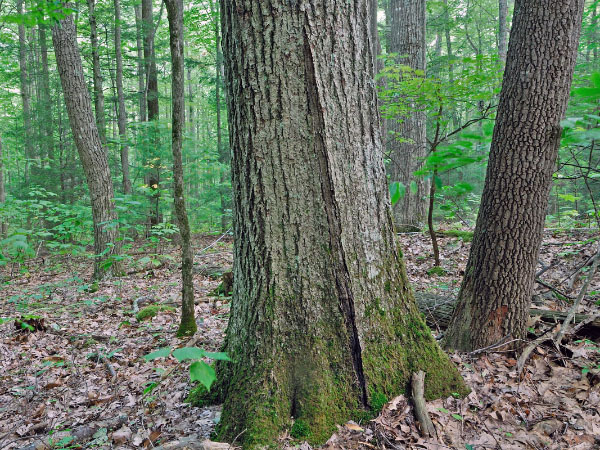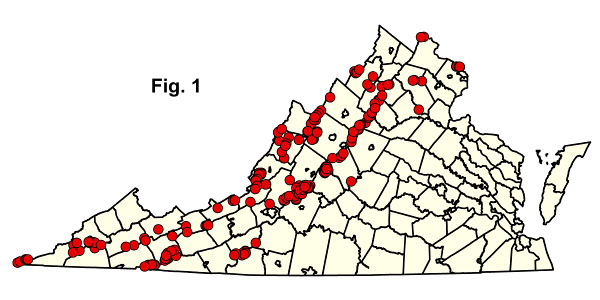

Virginia Department of Conservation and RecreationAn official website of the Commonwealth of Virginia Here's how you knowAn official websiteHere's how you know

Virginia Department of Conservation and RecreationAn official website of the Commonwealth of Virginia Here's how you knowAn official websiteHere's how you know
 Department of Conservation and Recreation
Department of Conservation and Recreation
 Table of Contents
Table of ContentsMontane Mixed Oak and Oak - Hickory Forests
This group contains relatively diverse, mixed oak and oak-hickory forests of submesic to subxeric mountain slopes and crests located mostly between about 600 m (2,000 ft) and 1,200 m (4,000 ft) elevation.
Montane mixed oak forests cover extensive areas in western Virginia and generally occupy intermediate positions along major environmental gradients such as soil moisture, soil fertility, and elevation. Soils occupied by montane mixed oak forests are typically less fertile than those of the true montane oak-hickory forests. Overstory composition contains mixtures of chestnut oak (Quercus montana), northern red oak (Quercus rubra), and white oak (Quercus alba). Overstory associates vary with geography and site conditions, but often include sweet birch (Betula lenta var. lenta), magnolias (Magnolia acuminata and Magnolia fraseri), sourwood (Oxydendrum arboreum), hickories (Carya spp.), red maple (Acer rubrum), tulip-tree (Liriodendron tulipifera), and white pine (Pinus strobus). The understories of mixed oak communities usually contain a substantial component of heaths, but also contain many non-ericaceous species such as witch hazel (Hamamelis virginiana var. virginiana), striped maple (Acer pensylvanicum), maple-leaved viburnum (Viburnum acerifolium), mountain holly (Ilex montana), buffalo-nut (Pyrularia pubera), and hazelnuts (Corylus cornuta var. cornuta and Corylus americana). The herbaceous component is relatively diverse, but often patchy and composed of both acidophiles and species characteristic of moderately fertile soils, including New York fern (Parathelypteris noveboracensis), galax (Galax urceolata), Curtis' goldenrod (Solidago curtisii), white wood aster (Eurybia divaricata), indian cucumber-root (Medeola virginiana), squawroot (Conopholis americana), halberd-leaved yellow violet (Viola hastata), speckled wood lily (Clintonia umbellulata), devil's-bit (Chamaelirium luteum), mountain golden-alexanders (Zizia trifoliata), and American lily-of-the-valley (Convallaria pseudomajalis).

Montane oak-hickory forests reach maximal importance on base-rich igneous, metamorphic, and subcalcareous sedimentary rocks. Two types occur throughout western Virginia: a submesic to mesic, rich type with a notably lush herb layer, and a drier, more acidic type with a diverse, often graminoid-dominated herb layer. Northern red oak, white oak, red hickory (Carya ovalis), and shagbark hickory (Carya ovata) are typical co-dominant trees, although in most stands oaks attain greater importance in the overstory than do hickories (Carya spp.), which often reach maximal density and cover in the understory. The chestnut oak is important only in the drier type, while mesophytic trees such as basswood (Tilia americana var. americana and var. heterophylla), bitternut hickory (Carya cordiformis), and sugar maple (Acer saccharum) are frequent associates in the rich type. The shrub layer of these communities is often sparse, and herbaceous composition varies with geography and site conditions. A widespread compositional variant on moist sites features extensive, nearly monospecific colonies of interrupted fern (Osmunda claytoniana). Fertile sites often support a diverse herbaceous flora, including such nutrient-demanding forbs as purple giant hyssop (Agastache scrophulariifolia), white bergamot (Monarda clinopodia), cutleaf coneflower (Rudbeckia laciniata var. laciniata), pale-leaved sunflower (Helianthus strumosus), richweed (Collinsonia canadensis), yellow jewelweed (Impatiens pallida), common black cohosh (Actaea racemosa), starry campion (Silene stellata), stout goldenrod (Solidago squarrosa), hairy-jointed meadow parsnip (Thaspium barbinode), and Appalachian meadow-rue (Thalictrum coriaceum). The luxuriance of such herb layers rivals that of the Rich Cove and Slope Forests. The drier type of montane oak-hickory forest features patch-dominance by Pennsylvania sedge (Carex pensylvanica), Porter's reedgrass (Calamagrostis porteri), wavy hairgrass (Avenella flexuosa), and xerophytic forbs.
Communities of this group are transitional to Northern Red Oak Forests at higher elevations and on poorer sites and to several other oak and oak-hickory forests at their lower-elevation limits. They are distinguished from both Basic Oak-Hickory Forests and Acidic Oak-Hickory Forests by their restriction to higher elevations generally > 600 m (2,000 ft) and a floristic composition that lacks many prominent low-elevation species (e.g., eastern redbud [Cercis canadensis var. canadensis] and flowering dogwood [Cornus florida]). They are distinguished from Oak / Heath Forests by their far greater diversity of understory and herbaceous plants. Many Montane Mixed Oak and Oak-Hickory stands represent vegetation formerly dominated or co-dominated by American chestnut (Castanea dentata), before mature individuals of this species were decimated by the introduced chestnut blight (Cryphonectria parasitica) in the early 20th century. Hickories (Carya spp.) are thought to have benefited greatly from the removal of American chestnut from the overstory, and their persistence and continued recruitment in contemporary oak-hickory forests may reflect fire exclusion in recent decades.
References: Adams and Stephenson (1983), Coulling and Rawinski (1999), Fleming (2007), Fleming and Coulling (2001), Fleming and Moorhead (2000), Johnson and Ware (1982), McCormick and Platt (1980), Rawinski et al . (1994), Rawinski et al . (1996), Stephenson (1982a), Stephenson (1982b), Stephenson and Adams (1991).Click here for more photos of this ecological community group.
 © DCR-DNH, Gary P. Fleming.
© DCR-DNH, Gary P. Fleming.
This group is represented by 244 plot samples from most counties in western Virginia and a few outlying Piedmont sites (Fig. 1). The classification of six community types is well supported by several large regional analyses of plot data. However, the Southern Appalachian representatives of the group need additional inventory to determine their full within-state distribution. Click on any highlighted CEGL code below to view the global USNVC description provided by NatureServe Explorer.

 Download a spreadsheet of compositional summary statistics (Excel) for each of the community types listed below.
Download a spreadsheet of compositional summary statistics (Excel) for each of the community types listed below.

